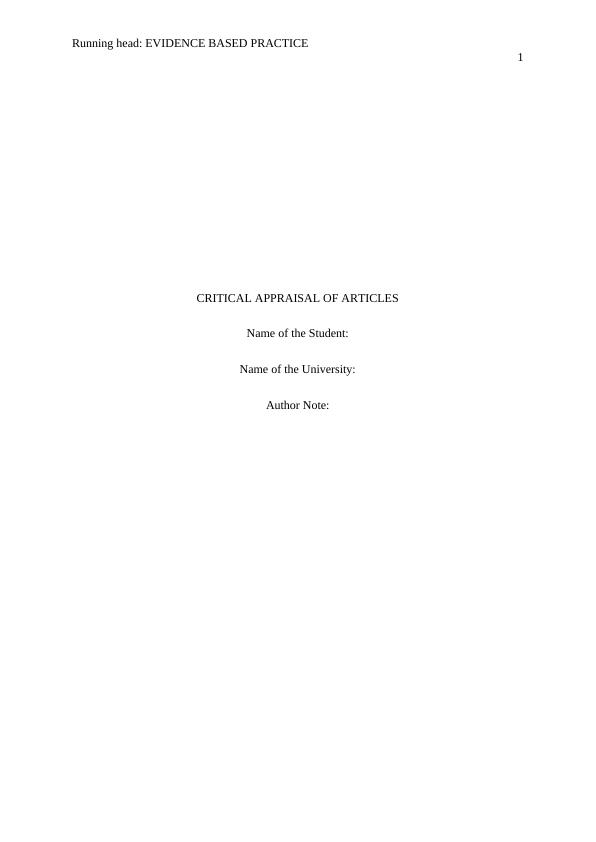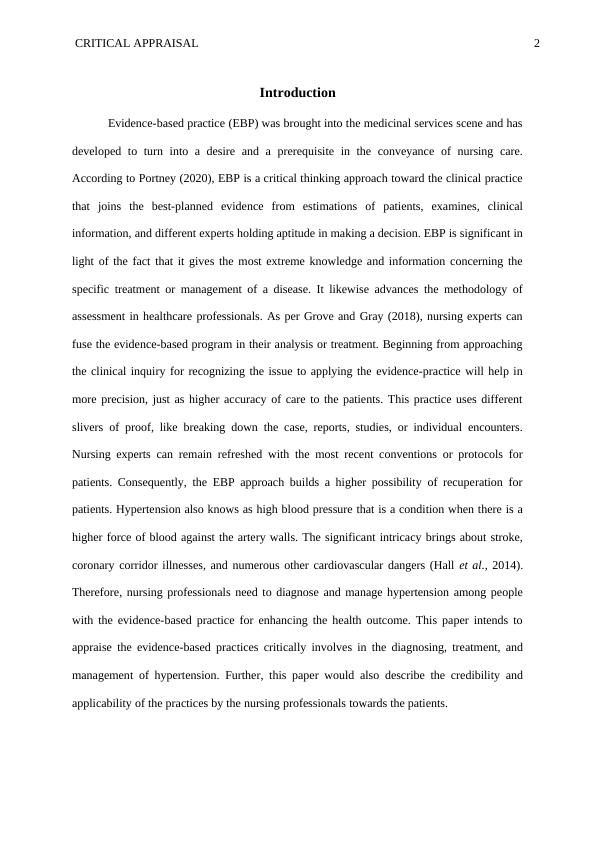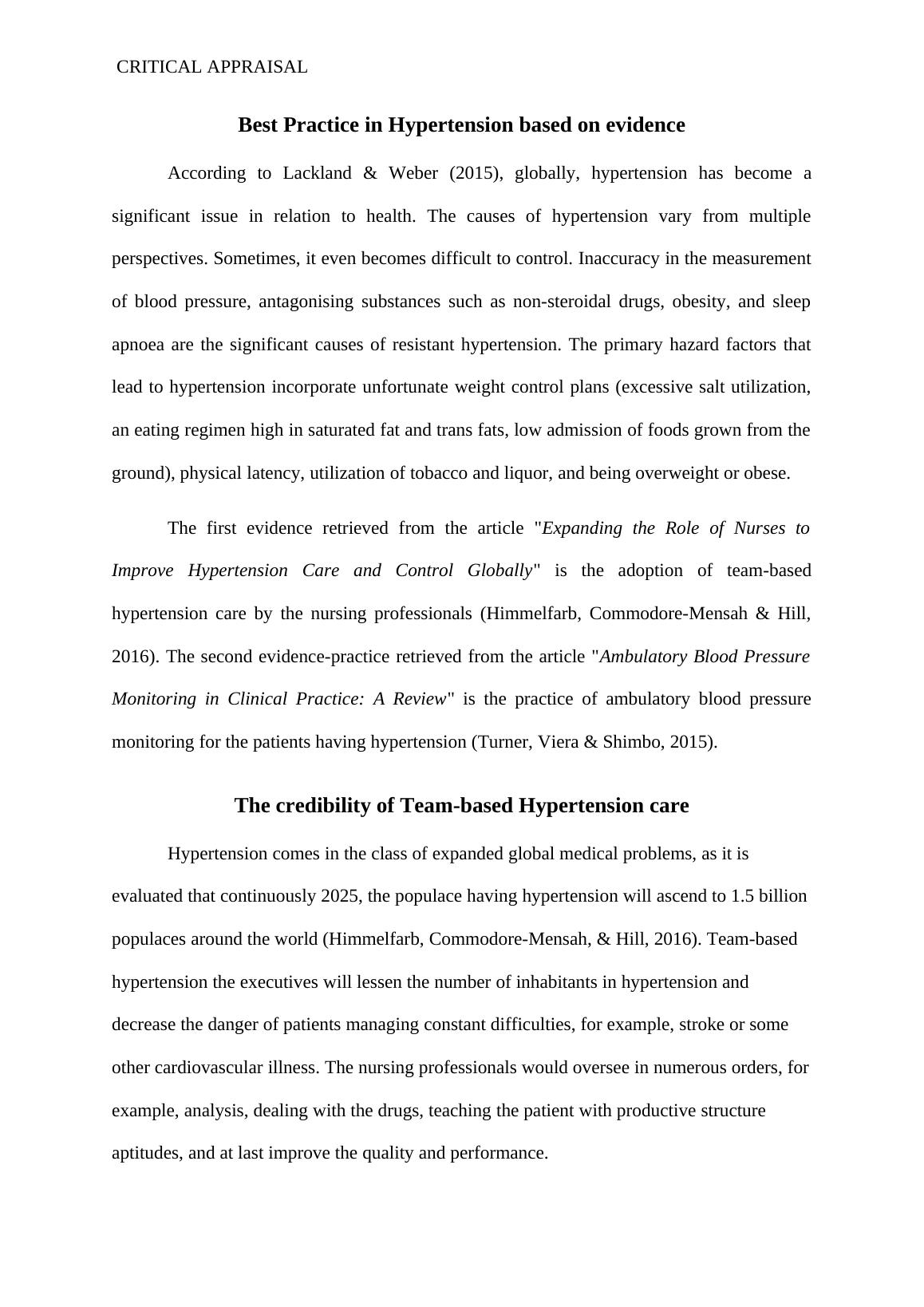Critical Appraisal of Articles : Evidence-based Practice
Added on 2022-08-29
15 Pages4567 Words30 Views
Running head: EVIDENCE BASED PRACTICE
1
CRITICAL APPRAISAL OF ARTICLES
Name of the Student:
Name of the University:
Author Note:
1
CRITICAL APPRAISAL OF ARTICLES
Name of the Student:
Name of the University:
Author Note:

CRITICAL APPRAISAL 2
Introduction
Evidence-based practice (EBP) was brought into the medicinal services scene and has
developed to turn into a desire and a prerequisite in the conveyance of nursing care.
According to Portney (2020), EBP is a critical thinking approach toward the clinical practice
that joins the best-planned evidence from estimations of patients, examines, clinical
information, and different experts holding aptitude in making a decision. EBP is significant in
light of the fact that it gives the most extreme knowledge and information concerning the
specific treatment or management of a disease. It likewise advances the methodology of
assessment in healthcare professionals. As per Grove and Gray (2018), nursing experts can
fuse the evidence-based program in their analysis or treatment. Beginning from approaching
the clinical inquiry for recognizing the issue to applying the evidence-practice will help in
more precision, just as higher accuracy of care to the patients. This practice uses different
slivers of proof, like breaking down the case, reports, studies, or individual encounters.
Nursing experts can remain refreshed with the most recent conventions or protocols for
patients. Consequently, the EBP approach builds a higher possibility of recuperation for
patients. Hypertension also knows as high blood pressure that is a condition when there is a
higher force of blood against the artery walls. The significant intricacy brings about stroke,
coronary corridor illnesses, and numerous other cardiovascular dangers (Hall et al., 2014).
Therefore, nursing professionals need to diagnose and manage hypertension among people
with the evidence-based practice for enhancing the health outcome. This paper intends to
appraise the evidence-based practices critically involves in the diagnosing, treatment, and
management of hypertension. Further, this paper would also describe the credibility and
applicability of the practices by the nursing professionals towards the patients.
Introduction
Evidence-based practice (EBP) was brought into the medicinal services scene and has
developed to turn into a desire and a prerequisite in the conveyance of nursing care.
According to Portney (2020), EBP is a critical thinking approach toward the clinical practice
that joins the best-planned evidence from estimations of patients, examines, clinical
information, and different experts holding aptitude in making a decision. EBP is significant in
light of the fact that it gives the most extreme knowledge and information concerning the
specific treatment or management of a disease. It likewise advances the methodology of
assessment in healthcare professionals. As per Grove and Gray (2018), nursing experts can
fuse the evidence-based program in their analysis or treatment. Beginning from approaching
the clinical inquiry for recognizing the issue to applying the evidence-practice will help in
more precision, just as higher accuracy of care to the patients. This practice uses different
slivers of proof, like breaking down the case, reports, studies, or individual encounters.
Nursing experts can remain refreshed with the most recent conventions or protocols for
patients. Consequently, the EBP approach builds a higher possibility of recuperation for
patients. Hypertension also knows as high blood pressure that is a condition when there is a
higher force of blood against the artery walls. The significant intricacy brings about stroke,
coronary corridor illnesses, and numerous other cardiovascular dangers (Hall et al., 2014).
Therefore, nursing professionals need to diagnose and manage hypertension among people
with the evidence-based practice for enhancing the health outcome. This paper intends to
appraise the evidence-based practices critically involves in the diagnosing, treatment, and
management of hypertension. Further, this paper would also describe the credibility and
applicability of the practices by the nursing professionals towards the patients.

CRITICAL APPRAISAL 3
Best Practice in Hypertension based on evidence
According to Lackland & Weber (2015), globally, hypertension has become a
significant issue in relation to health. The causes of hypertension vary from multiple
perspectives. Sometimes, it even becomes difficult to control. Inaccuracy in the measurement
of blood pressure, antagonising substances such as non-steroidal drugs, obesity, and sleep
apnoea are the significant causes of resistant hypertension. The primary hazard factors that
lead to hypertension incorporate unfortunate weight control plans (excessive salt utilization,
an eating regimen high in saturated fat and trans fats, low admission of foods grown from the
ground), physical latency, utilization of tobacco and liquor, and being overweight or obese.
The first evidence retrieved from the article "Expanding the Role of Nurses to
Improve Hypertension Care and Control Globally" is the adoption of team-based
hypertension care by the nursing professionals (Himmelfarb, Commodore-Mensah & Hill,
2016). The second evidence-practice retrieved from the article "Ambulatory Blood Pressure
Monitoring in Clinical Practice: A Review" is the practice of ambulatory blood pressure
monitoring for the patients having hypertension (Turner, Viera & Shimbo, 2015).
The credibility of Team-based Hypertension care
Hypertension comes in the class of expanded global medical problems, as it is
evaluated that continuously 2025, the populace having hypertension will ascend to 1.5 billion
populaces around the world (Himmelfarb, Commodore-Mensah, & Hill, 2016). Team-based
hypertension the executives will lessen the number of inhabitants in hypertension and
decrease the danger of patients managing constant difficulties, for example, stroke or some
other cardiovascular illness. The nursing professionals would oversee in numerous orders, for
example, analysis, dealing with the drugs, teaching the patient with productive structure
aptitudes, and at last improve the quality and performance.
Best Practice in Hypertension based on evidence
According to Lackland & Weber (2015), globally, hypertension has become a
significant issue in relation to health. The causes of hypertension vary from multiple
perspectives. Sometimes, it even becomes difficult to control. Inaccuracy in the measurement
of blood pressure, antagonising substances such as non-steroidal drugs, obesity, and sleep
apnoea are the significant causes of resistant hypertension. The primary hazard factors that
lead to hypertension incorporate unfortunate weight control plans (excessive salt utilization,
an eating regimen high in saturated fat and trans fats, low admission of foods grown from the
ground), physical latency, utilization of tobacco and liquor, and being overweight or obese.
The first evidence retrieved from the article "Expanding the Role of Nurses to
Improve Hypertension Care and Control Globally" is the adoption of team-based
hypertension care by the nursing professionals (Himmelfarb, Commodore-Mensah & Hill,
2016). The second evidence-practice retrieved from the article "Ambulatory Blood Pressure
Monitoring in Clinical Practice: A Review" is the practice of ambulatory blood pressure
monitoring for the patients having hypertension (Turner, Viera & Shimbo, 2015).
The credibility of Team-based Hypertension care
Hypertension comes in the class of expanded global medical problems, as it is
evaluated that continuously 2025, the populace having hypertension will ascend to 1.5 billion
populaces around the world (Himmelfarb, Commodore-Mensah, & Hill, 2016). Team-based
hypertension the executives will lessen the number of inhabitants in hypertension and
decrease the danger of patients managing constant difficulties, for example, stroke or some
other cardiovascular illness. The nursing professionals would oversee in numerous orders, for
example, analysis, dealing with the drugs, teaching the patient with productive structure
aptitudes, and at last improve the quality and performance.

CRITICAL APPRAISAL 4
Appraise
The strength of the article is the qualification of the authors. The article is written by
Cheryl R. Dennison Himmelferb, who is a registered nurse who has completed a Ph.D. In
addition to these qualifications, the author is also affiliated with FAAN, ANP, FAHA, and
FPCNA. Another author's name is Yvonne commodore-Mensah, who also has the credential
of RN, Ph.D., FAAN, and FAHA. Thus, the authors have relevant knowledge and expertise
in writing articles that provide the evidence-practice in the management or treatment of
hypertension among the patients. The article states the role of nursing professionals in
providing effective care and performing efficient practices in the management and treatment
of hypertension.
The major aim of the article is to provide a wider role to nursing professionals in their
practices of delivering care. Thus, authors have recommended for a team-based approach for
management of hypertension. An important element of the finest hypertension care models is
a multiple and numerous group that teams up in carrying hypertension care administrations.
A team-based method shows restraint focused, along with tailoring care that would address
the issues of patients. It is frequently represented as a significant aspect of a multiple areas
methodology, with frameworks that support for clinical dynamic (e.g., calculations of
treatment), effective communication, along with patient self-administration. The author has
found a gap in current practices delivered by the nurses in performing their treatment towards
hypertension. The health disparities are the major gap of existing practice, and therefore, the
author has argued that expanding the role of nursing professionals is the only effective
strategy to improve and control hypertension.
The article has used secondary qualitative design for recommending the team-based
approach with relevant supporting articles. The exemplars were provided in the article
supporting the recommendation made by the author. Multiple studies were incorporated
Appraise
The strength of the article is the qualification of the authors. The article is written by
Cheryl R. Dennison Himmelferb, who is a registered nurse who has completed a Ph.D. In
addition to these qualifications, the author is also affiliated with FAAN, ANP, FAHA, and
FPCNA. Another author's name is Yvonne commodore-Mensah, who also has the credential
of RN, Ph.D., FAAN, and FAHA. Thus, the authors have relevant knowledge and expertise
in writing articles that provide the evidence-practice in the management or treatment of
hypertension among the patients. The article states the role of nursing professionals in
providing effective care and performing efficient practices in the management and treatment
of hypertension.
The major aim of the article is to provide a wider role to nursing professionals in their
practices of delivering care. Thus, authors have recommended for a team-based approach for
management of hypertension. An important element of the finest hypertension care models is
a multiple and numerous group that teams up in carrying hypertension care administrations.
A team-based method shows restraint focused, along with tailoring care that would address
the issues of patients. It is frequently represented as a significant aspect of a multiple areas
methodology, with frameworks that support for clinical dynamic (e.g., calculations of
treatment), effective communication, along with patient self-administration. The author has
found a gap in current practices delivered by the nurses in performing their treatment towards
hypertension. The health disparities are the major gap of existing practice, and therefore, the
author has argued that expanding the role of nursing professionals is the only effective
strategy to improve and control hypertension.
The article has used secondary qualitative design for recommending the team-based
approach with relevant supporting articles. The exemplars were provided in the article
supporting the recommendation made by the author. Multiple studies were incorporated

End of preview
Want to access all the pages? Upload your documents or become a member.
Related Documents
EBP In Diagnosing Hypertension | Nursinglg...
|5
|888
|12
Determining The Credibility Of Evidence And Resourceslg...
|5
|1170
|19
Evidence in Health and Social Care Practicelg...
|15
|4444
|423
Evidence Based Practice in Nursing: Guidelines and Recommendations for Managing Hypertension in Australialg...
|18
|3569
|82
Critical Review Assignment 2022lg...
|18
|4044
|50
Assignment on Evidence Based Projectlg...
|4
|812
|18
